

It took Edward and Mr. Ferguson an hour to walk to Yale. There was no sign of the fire near the town. A train, its engine puffing white smoke, shunted up and down the tracks. It was collecting cars and depositing others on spurs that ran off the main track. When it pulled up in front of a water tower, a man lowered a long trough and let water pour into the engine’s boilers. It would take a full tank to make enough steam to pull the train up the steady incline of the canyon and into the high country beyond.
The train was just getting ready to leave as Edward collected his ticket from the station master. It had two coaches, as well as several freight cars and a tender loaded with wood for the boiler. The coaches were crude affairs, just rough lumber painted a dull red. Inside, people sat on benches that ran down either side. There were spaces for windows, but they had no glass. Edward took a seat near the door and stuffed his satchel between his legs; Mr. Ferguson sat opposite him.
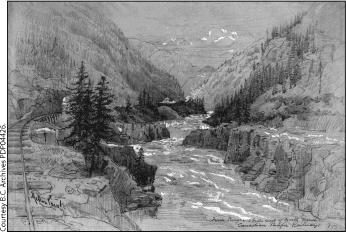
Building a railway through the Fraser Canyon took sweat, guts, and dynamite, and led to many injuries and deaths especially among Chinese workers.
As the train clattered off into the canyon, the coaches rattled and swayed: the rails had only just been laid. They hadn’t yet settled into the road bed, but Edward was too busy looking out at a wilderness of rocks and staggering peaks to be bothered by the rough ride. Mr. Ferguson was chattering to the other passengers in his Scottish brogue, telling them about the fire he and Edward had escaped.
“I’m a Highlander, by the grace of God,” Edward heard him say, “but ah dinnae ken a fire like the one we was just through. That’s a brave lad, young Eddie, he found the way down to the river. That’s what saved us.”
As the train chugged along, Edward saw that the wall of the canyon stretched almost straight down below the tracks. He could see water, muddy with silt, churning and frothing a hundred feet below. The train was occasionally plunged into darkness as it passed through tunnels, which had been dug out where the mountainside was almost vertical.
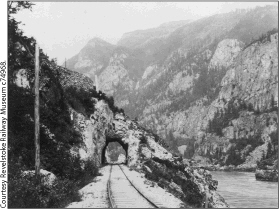
Tunnel No. 7 above Yale allowed trains to cling to Fraser Canyon cliffs.
After a few hours, the canyon widened and, before Edward knew it, the train had left the narrow Fraser River and begun to make its way along another, quieter stream. He knew from its clear, green water that they had entered the valley of the South Thompson River, named after the great explorer who had first travelled through the Rocky Mountains and into British Columbia.
That evening, the train stopped at Van Horne, close to where the river widened out into Kamloops Lake. Van Horne was more of a construction camp than a village and piles of steel rails lay beside the tracks. Gangs of men drove oxen that were dragging timber, which would be made into ties on which the rails would be set. Off in the distance, he could see a collection of tents.
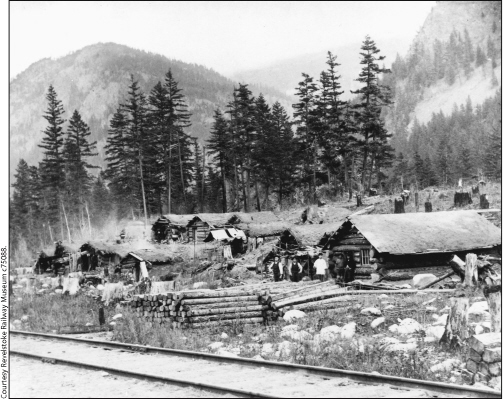
Chinese workers were involved in clearing routes through the mountains on the great railway project. They lived in makeshift shacks, such as these, along the way.
A line of men moved back and forth between the railway and the tents. Edward noticed that shacks were scattered alongside the railway, which all seemed to be filled with Chinese workers. Outside one shack there was a man sitting on a chair getting his hair cut. The barber was careful not to touch his pigtail, which Edward had heard was their way of showing loyalty to the Chinese emperor.
The men wore loose clothes that looked like pajamas. Some had only sandals on their feet and most were wearing flat, wide-brimmed hats. The men belonged to the construction gangs collected by the railway contractor, Andrew Onderdonk. He’d come up from the States, where he helped build the Northern Pacific Railway. His task was to oversee the final completion of the Canadian Pacific.
Edward knew that a lot of people didn’t like the idea of the railway bringing in workers from China. But he’d also heard that this was the only to get the railway built on time. He’d read in the British Colonist that the prime minister, Sir John A. Macdonald, had made that clear to Parliament, when he said that if they wanted the railway they’d have to accept the use of Chinese labour. “[E]ither you must have [Chinese] labour or you cannot have a railway.” Edward had heard there were six thousand Chinese men working on the railway; it seemed like they were all there in Van Horne.
The countryside was flatter there, and drier and browner. Track was being laid more quickly, but still there was no train service east of this camp. Edward had to wait two days for the next steamer, which would take passengers through a series of lakes, beginning with Kamloops Lake and ending on the eastern-most shore of Shuswap Lake.
The steamer that Edward boarded on Saturday was even smaller than the Adelaide. Captain Fortune stood at the narrow gangplank leading onto the Peerless and collected tickets. He noticed Edward was travelling alone. “Where are you bound for, son?”
By now, Edward was a little fed up with all the questions people kept asking him. Some seemed to think he was just a child who shouldn’t be going about on his own.
“I’m going east,” Edward answered, showing Captain Fortune his ticket.
6,000 Chinese Workers Called Him “Boss”
Andrew Onderdonk was an American railway contractor, born in New York to an old English-Dutch family. He worked on railways in the United States before winning the contract to build the 342-kilometre section of the CPR from Burrard Inlet to Savona, near Kamloops. When he finished that section, he was told to push on and got as far as Eagle Pass, another 202 kilometres, before running out of rails. His crew was left at Craigellachie, where they met the navvies coming from the East. The Last Spike was driven there on November 7, 1885.
As the construction boss for the toughest part of the Canadian Pacific Railway, Onderdonk could never have finished the job without the tireless work of the 6,000 Chinese labourers he brought in from California and China. The Canadian government had insisted that Onderdonk hire Chinese workers because they would work for lower wages than White Canadians. At first, he brought in Chinese workers from California, but most deserted to work in the gold fields. Onderdonk then turned to China where he engaged agents to recruit peasants in an area plagued by famine. Floods and drought had uprooted millions of destitute peasants in Guangdong Province. Those who could find work earned about seven cents a day. They were desperate.
Onderdonk moved his wife and daughter Eva to Yale, British Columbia, for the duration of the project. After completing his work on the CPR, he built a railway in South America and worked on major engineering projects, including the Trent Canal in Ontario and the building of the Victoria Bridge in Montreal. He died in 1905 in New York.
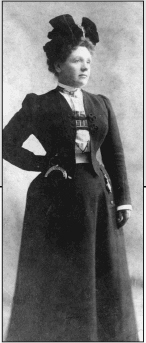
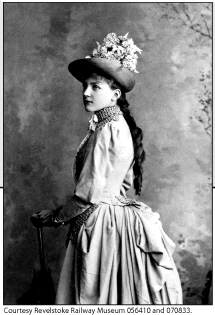
Andrew Onderdonk’s wife and his daughter Eva (right) lived in Yale on the Fraser River during construction of the railway.
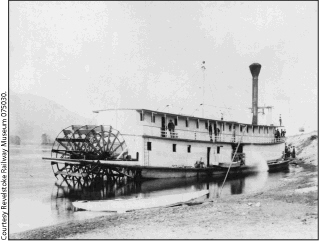
Edward boarded the Peerless, a small paddlewheel vessel, to cross Shuswap Lake.
“Well, that’s the way this boat’s going, lad. Welcome aboard.”
Edward marvelled again at the beauty of the countryside. Rolling hills stretched out from either bank. When they entered Kamloops Lake, he stood at the stern watching as the Peerless left behind a frothy wake. He saw Natives for the first time, when the boat stopped at Kamloops; he thought they looked a dismal lot. One was leading a mule up the road from the dock. He was moving slowly and Edward wondered where he was going. Several children played in the dust beside the dock. He was watching them when he noticed Mr. Ferguson standing beside him.
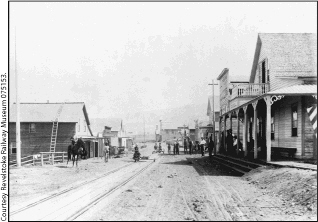
The village of Kamloops was a key supply point for railway builders, seen here in this photograph from the 1880s.
“ This is where I get off,” he told Edward. “See the smoke from that sawmill up yonder? That’s where I make ties for the railway. Got the contract for this whole section of the line.”
Mr. Ferguson told Edward that he and Donald A. Smith, the president of the CPR, were boyhood chums from back home in Scotland.
“Aye, we were inseparable in the auld country. And in thirty years in Canada, we’ve ne’er lost our friendship!”
That night, while Edward slept on board, the steamer navigated its way through the lakes. On Sunday evening, exactly a week after Edward had left home, the Peerless tied up at a ramshackle, rough-hewn wooden dock at Eagle Landing. It was dark as the Peerless dropped anchor. Edward was afraid: he was stepping into the unknown as he made his way down the gangplank. He could see a number of buildings dimly lit by lanterns shining faintly through their grimy windows and he heard what sounded like celebrating. He was anxious to get to the Prairies where the war was being fought. He wanted to be in it more than ever.
A gang of men stood on the dock watching the passengers alight. They wore rough clothing and most had unkempt beards. Their appearance worried him and he found their language coarse. Several of the men were holding tin cans with candles in them, casting a ghostly air about the place. All together, the sight made him even more nervous.
Suddenly, he heard someone call his name. “Edward! Over here!” He peered through the darkness. Sure enough, he recognized Tom Freeman, a schoolmate who had been two years ahead of him at Victoria Central. Edward was relieved to meet someone he knew.
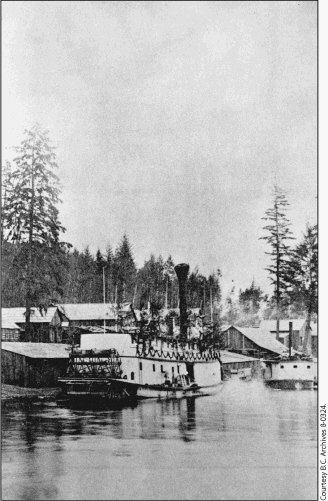
A makeshift dock awaited the Peerless upon Edward’s arrival at Eagle Landing on the east shore of Shuswap Lake. The settlement is now called Sicamous, B.C.
They talked a bit, each explaining what they were up to. Tom said track was being laid eastward from Eagle Landing through Eagle Pass.
“It won’t be too many more months before the railway is finished,” Tom told him. “Meanwhile, you’ll have to beat your way over to Farwell, on the other side of Eagle Pass. The track from the east will be there soon.”
Tom offered to show Edward the way to the Royal Hotel. The two set out on a rutted road lined with small buildings. Edward was left standing alone outside the hotel after Tom explained he had to go off a mile or two, to a camp outside the town.
Edward talked to himself a bit while he screwed up enough courage to go inside. He was beginning to realize that being raised in a comfortable home in Victoria hadn’t really prepared him for this adventure.
He timidly opened the big wooden door, hewn from cedar slabs from the nearby forest, and entered the Royal Hotel: the place didn’t look very royal. He found himself in a long room with a bar running from end to end. Behind it, several men poured drinks for fifty or sixty terribly coarse and rough looking customers, all of whom seemed to be talking at once. Most were swearing, and it seemed to Edward that several were on the verge of fighting.
No one paid Edward any mind. After a minute or two, having become accustomed to the candle light, he convinced himself that no one was likely to hurt him. He approached the bar, where a man who seemed to be in charge stood moving bottles and glasses around. He had a large cigar in his mouth and wore a dirty white apron that hung over a sagging stomach. Edward asked if he could get a room.
The man looked at him quizzically.
“Boy, what are you doing here? We don’t get many kids hanging around here on their own.”
“I’m on my way to the Rebellion and I’m joining the militia,” Edward replied. “But first I need to get to Farwell.”
The noise behind Edward seemed to fade away. The seconds slipped by. He heard a tin mug clatter onto the floor. It was as if books were falling, one at a time, off the shelf in his bedroom. He felt a breath on his neck, but was afraid to turn around. Edward looked into the eyes of the man behind the bar, but the man just stared back.
The bartender wiped his mouth with his sleeve. Stray hairs from his nearly bald head fell onto his forehead. While swirling a dirty rag across the counter to soak up a puddle of spilled beer, he began firing questions at Edward.
“How did you get here? What are you going to do at Farwell? Where’s your folks?”
Edward decided he’d better give good answers. He spoke truthfully, explaining his wish to join the Canadian Militia, and that he was making his way to Farwell in order to catch a train that would take him onto the Prairies. The bartender mulled over his story.
Finally, the man leaned across the bar, his head only a few inches from Edward’s face. “You can have a bed upstairs. It won’t cost you anything.”
Edward heaved a sigh of relief. Maybe Eagle Landing wasn’t going to be so bad after all!
The bartender pointed to a ladder propped against the wall at the end of the bar room. It reminded Edward of the ladders he’d seen in hay barns. No stairs?
“That’s the way up,” the bartender called after him. “You’ll find a bed up there.”
Edward was weary by now. He pulled himself up the ladder and climbed through the hole in the ceiling. He found himself in a loft lit by a single candle. He could make out rows of folding canvas cots jammed up against either wall. They had thin straw mattresses but no blankets. Not a single one was occupied. He looked around for a toilet, but he couldn’t find anything. Through a crack in the floor, he could see into the bar room below. Tobacco smoke drifted up like a fog.
Edward thought about looking elsewhere to sleep, but he was tired. Rather than venture back down the ladder, he chose a cot that stood in the far corner of the loft, its head and one side protected by the walls. He decided to sleep in his clothes. Extracting a small blanket from his satchel, he lay down, put the little bag under his head for a pillow, and tried to fall asleep.
But he couldn’t get to sleep. After awhile, he could hear and feel men coming up the ladder. The lone candle had burned out and it was dark, except for the chain of light coming from the crack in the floor. Once in the loft, the men stumbled about, swearing at each other before falling onto the cots in drunken stupors.
A man dropped onto the cot next to Edward. He could sense the heat and the smell of the man’s body, as well as his drunken breath. Edward was trembling, wishing he had gone somewhere else. Eventually the men quieted down and Edward managed to fall into a fitful sleep. He woke up often, disturbed by the loud snores coming from the cot next to him.